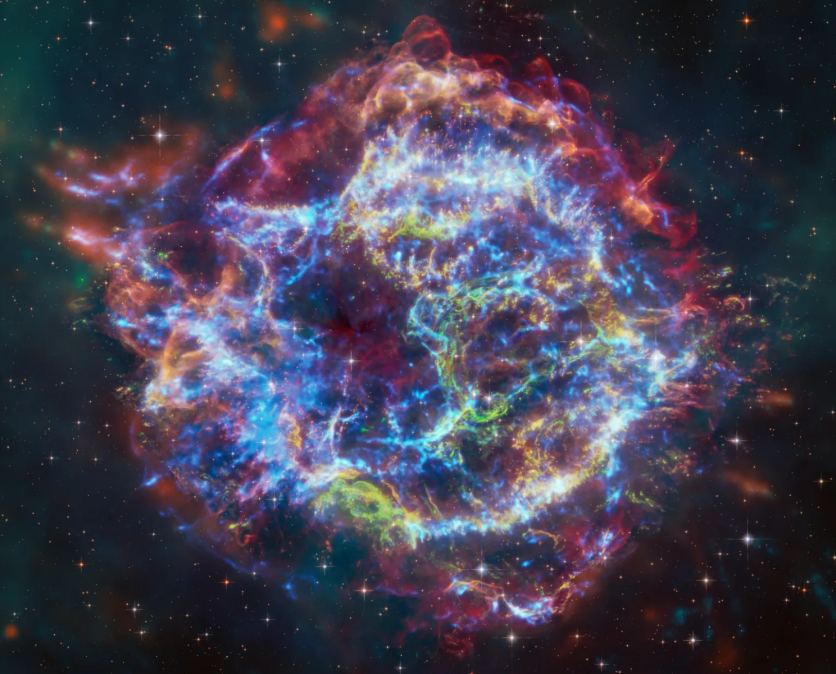Astronomers have utilized data from NASA's Chandra X-ray Observatory and James Webb Space Telescope to explore the intricacies of the well-known supernova remnant, Cassiopeia A (Cas A).
This marks the first time to combine data from these two potent instruments, yielding fresh insights into the destroyed star called the "Green Monster," first identified in Webb data in April 2023.

The 'Green Monster'
The research not only demystifies the Green Monster but also reveals new details about the explosion that birthed Cas A roughly 340 years ago, as observed from Earth.
The composite image, a fusion of X-rays from Chandra, infrared data from Webb, and optical data from Hubble, with supplementary contributions from NASA's Spitzer Space Telescope, captures the essence of Cas A.
Chandra's X-ray data reveals hot gas primarily emanating from supernova debris of the obliterated star, enriched with elements like silicon and iron.
In the outer reaches of Cas A, the expanding blast wave collides with previously expelled gas, producing X-rays by energetic electrons tracing magnetic field lines in the blast wave, according to NASA.
Webb's infrared capabilities highlight emissions from dust warmed by its proximity to the hot gas witnessed by Chandra and from much cooler supernova debris. Hubble's optical data contributes to the visualization of stars in the vicinity.
A detailed analysis reveals that filaments in the outer segments of Cas A, attributed to the blast wave, closely align with the X-ray characteristics of the Green Monster.
The Green Monster, distinct in its composition with reduced iron and silicon compared to supernova debris, is interpreted as a result of the blast wave colliding with surrounding material, corroborating earlier indications from Webb's standalone observations.
Pristine Debris
NASA said the remnants of the explosive event are heated to temperatures reaching tens of millions of degrees by shock waves, reminiscent of sonic booms from a supersonic plane.
Webb captured some material unaffected by shock waves, representing what scientists term "pristine" debris. To delve deeper into the supernova explosion, the researchers compared Webb's view of pristine debris with X-ray maps depicting radioactive elements produced in the supernova.
Utilizing data from NASA's Nuclear Spectroscopic Telescope Array (NuSTAR), radioactive titanium is still observable today, and Chandra's mapping of the locations of iron was overlaid.
The resulting images showcase iron-rich debris, radioactive titanium, and pristine debris. This analysis suggests that X-ray-visible radioactive material played a role in shaping the pristine debris at Cas A's center, forming distinctive cavities.
The intricate structures in the pristine debris likely originated from the turbulent mixing of the star's inner layers with hot, radioactive matter generated during the core's collapse under gravity.
The collaboration between Chandra, Webb, and other telescopes has provided a deeper understanding of Cas A's complex dynamics, unraveling the story of a celestial phenomenon born from the remnants of a stellar explosion.
Related Article : NASA's James Webb Space Telescope Captures Image of an Exploded Star in High-Definition View

ⓒ 2025 TECHTIMES.com All rights reserved. Do not reproduce without permission.




